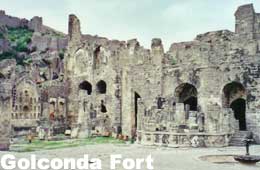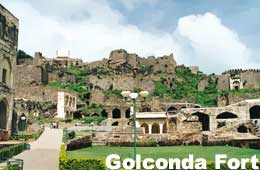| India Profile » Monuments and Temples in India » Monuments of Golconda Fort | |
Monuments of Golconda Fort, Hyderabad | |
 | |
|
The Golconda Fort is known as the Shepherd's Hill or Golla Konda in Telugu. There is an interesting story behind the construction of the fort. In 1143 AD, shepherd boy took notice of an idol on the rocky hill called 'Mangalavaram'. He told about the idol to the Kakatiya king, who was ruling Hyderabad at that time. The king constructed a mud fort around the holy spot. Almost 200 years later, Bahamini rulers in 1364 took possession of the fort. The mud fort was converted into a massive fort of granite from 1507 AD by the first three Qutub Shahi kings over a period of 62 years. The fort was extended to a circumference of around 5 km. The rule of the Qutub Shahs at Golconda came to an end in 1687 AD with the capture of the fort by the Mughal emperor Aurangzeb. He nearly annihilated the fort and left it into a mass of undignified ruins. Golconda Fort is a complex comprising of four distinct forts. There is a 10 km long outer wall with 87 semi-circular bastions. The some of the bastions are still mounted with cannons. The fort has eight gateways, four drawbridges and several royal apartments, halls, temples, mosques, magazines and stables inside. The primary structure of the fort is laid out in a series of enclosures that holds the public and administrative structures as well as the royal residences and halls. The Nagina Bagh also lies within an enclosure but it is in utter ruins. One can enter the Golconda Fort through the Fateh Darwaza or the Victory Gate in the southeast corner, called after the march of Aurangzeb after his victory. The gate is studded with iron spikes so that even the elephants cannot knock them down. The Fateh Darwaza has terrific acoustic effects, which characterizes the engineering skills of the architects of Golconda. The echo of the clap of hands at the center of the dome can be heard clearly at Bala Hisar Pavilion, which is the highest point of the fort and is around 1 km away. The acoustic feature was probably added deliberately to act as a warning note to the soldiers in case of an invasion. The Bala Hisar Gate is the most impressive of all the gateways. The decoration of the gateway is done by putting the mythical beasts and lions on stucco panels of the spandrels. One has to climb some 380 uneven stone steps from the Bala Hisar Gate to reach the fort. Akanna and Madanna were two important Hindu officials in the court of Qutub Shah. There offices are further up. The large iron weights are half buried in the ground. The ruins of the Ambar Khana or the granary and the Bari Baoli or the step well can be seen near the upper terrace. There is also see a Hindu temple of Madanna, which belongs to the Kakatiya period. It is carved out of a huge boulder and has colorful frescos of the Goddess Kali on the white-painted facade. There is also evidence to suggest that the fort had an efficient arrangement of water supply to the resident areas over the hill. You can see the queer clay pipes as you climb the steps. The mosque built by Taramathi is also an important structure. Ibrahim Qutub Shah built a small mosque in 1518 AD, which is distinguished by the prominent corner minarets. The courtyard of the mosque extends up to the ramparts providing magnificent views of the landscape below. There is a small Rama Mandir under the boulders close to the mosque. Ram Das, revenue official who was jailed by Abul Hasan Tana Shah for misusing state funds, carved figures of Rama, Lakshman and Hanuman on the rock surface in the cell. At the top is the Bala Hisar Baradari, which is a wind-swept pavilion. It has twelve arches and three storeys and used as a durbar hall. Strong piers divide it into vaulted bays where a raised chamber with triple arches opens from the rear wall. A stone throne is on the uppermost terrace. A pavilion, a little away in the hills, is believed to have housed Taramathi, Abul Hasan's paramour. The Baradari has another engineering marvel. It is the natural air-conditioning provided by an empty space between the double walls, which sucks the air and releases it with accumulated pressure in the chambers.
The zinnia quarters or the Rani Mahal are down the narrow steps. The tombs of the Qutub Shahi kings are 1 km to the north outside the fort. They are remarkable for their design and implementation. This complex served as the burial ground of the family. Some of the tombs are above the ground and placed upon a huge platform of arches. The tombs are square in shape and are coated with plaster, bordered with small minarets each supporting a bulbous dome. This design became the style mark of the Qutub Shahi Architecture of the Deccan. There is a mortuary baths or the hammam to the right of the portico. These baths were meant to give ritualistic bath to the deceased royalty and harem ladies before the burial the Banjara Gate. To the west of the Hammam is the Tomb of Sultan Quli Qutub Khan, founder of the dynasty capital city of Golconda.. Tomb of Ibrahim Qutub Shah is towards the far south of the Hammam. It was once beautifully ornamented with enamel-work and paint. The Tomb of Mohammed Qutub Shah (1612-26) is directly towards the Hammam. It is the most impressive structure of the complex. Mohammad Qutub Shah was the founder of the city of Hyderabad. There are two separate pavilions built over a rock outside the Golconda are the Taramati Gana Mandir and the Premamati Nritya Mandir. here the two legendary sisters Taramati and Premamati once lived. The sisters gave dance performances on a circular dais in the Kala Mandir. It was a two-storied structure was visible from the king's durbar on top of the Golconda Fort. It is believed that there was also a secret underground tunnel leading from the Durbar Hall to one of the palaces at the foot of the hill. The fortress city within the walls was famous for its diamond trade and the famous Koh-I-Noor diamond is said to have come from here. |
|
 |
 The Golconda Fort is a magnificent fortress complex, which lies on the western outskirts around 11km from Hyderabad. Originally a mud fort, it was later reconstructed in stone. Since then it has had a variety of additions by the various rulers of the area. The fortress is built on a 120 metres high granite hill surrounded by massive castled ramparts.
The Golconda Fort is a magnificent fortress complex, which lies on the western outskirts around 11km from Hyderabad. Originally a mud fort, it was later reconstructed in stone. Since then it has had a variety of additions by the various rulers of the area. The fortress is built on a 120 metres high granite hill surrounded by massive castled ramparts.  These palaces are built on huge platforms and had high ceilings. The walls are covered with decorative niches, alcoves and cornices, inspired by Persian design. The tall wooden columns, no more there, reveal the bare structure of the triple vaulted hall. The graceful beautification on the stucco is done with the arabesque in the roundels above the side arches.
These palaces are built on huge platforms and had high ceilings. The walls are covered with decorative niches, alcoves and cornices, inspired by Persian design. The tall wooden columns, no more there, reveal the bare structure of the triple vaulted hall. The graceful beautification on the stucco is done with the arabesque in the roundels above the side arches.